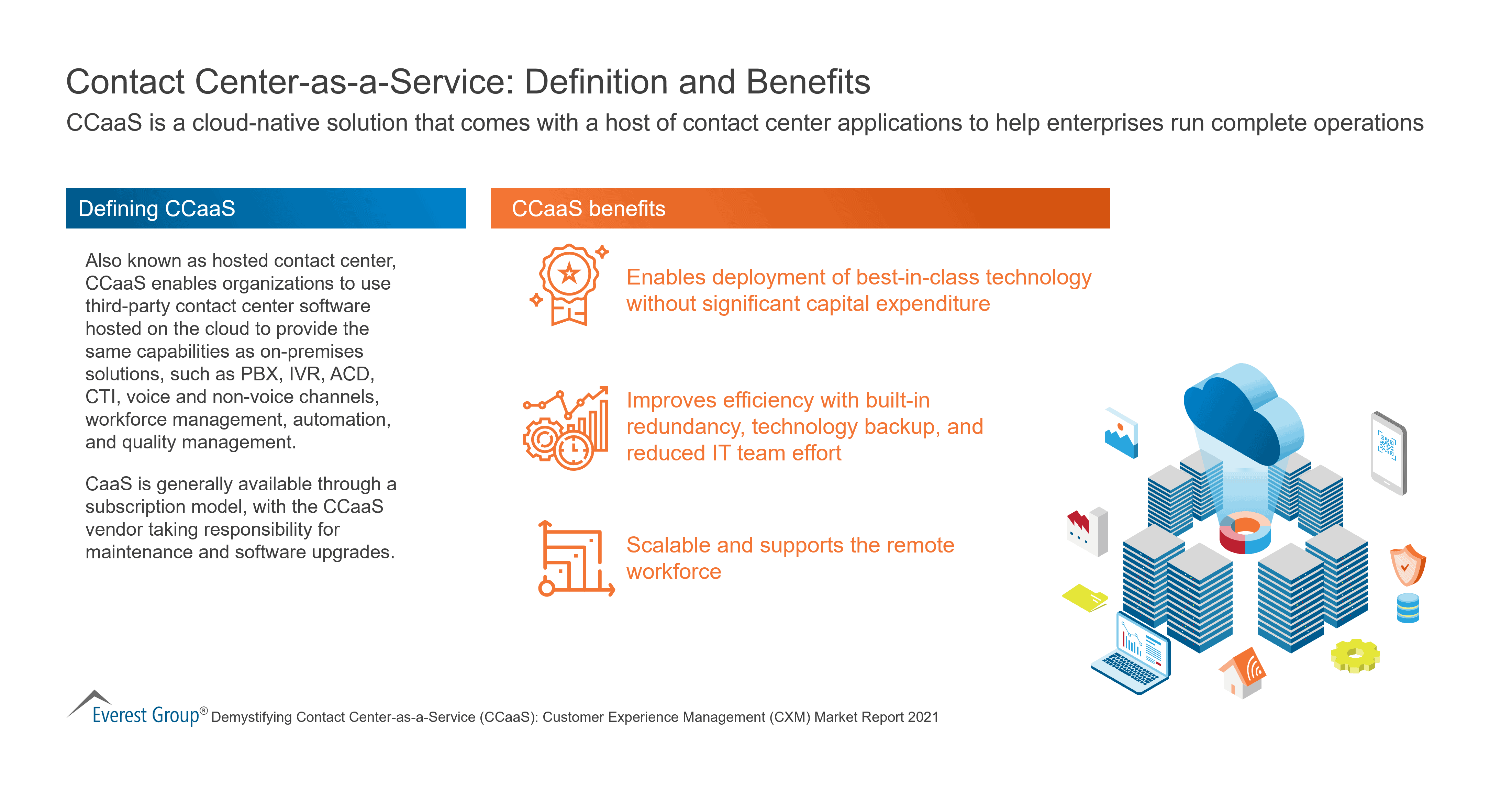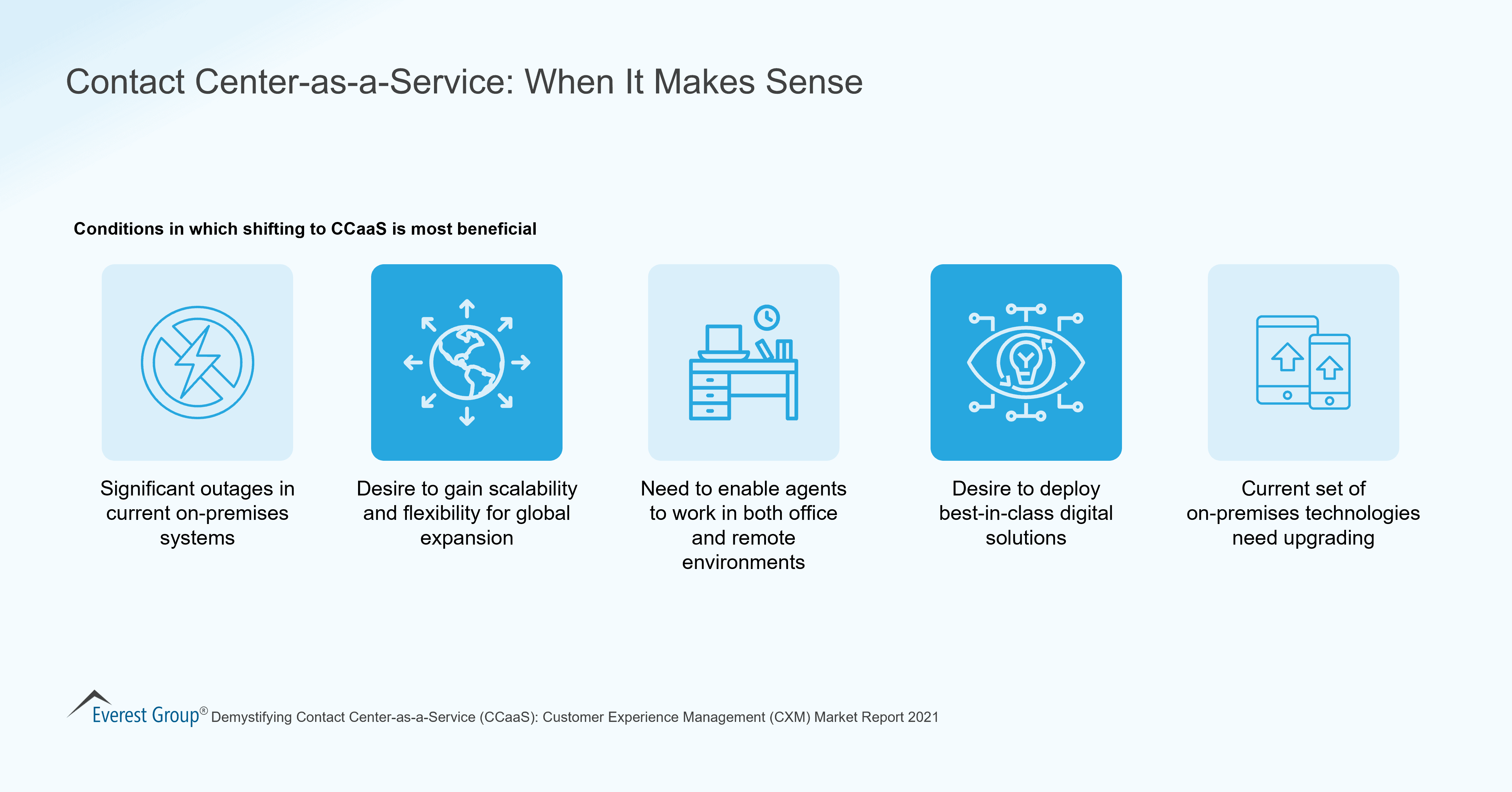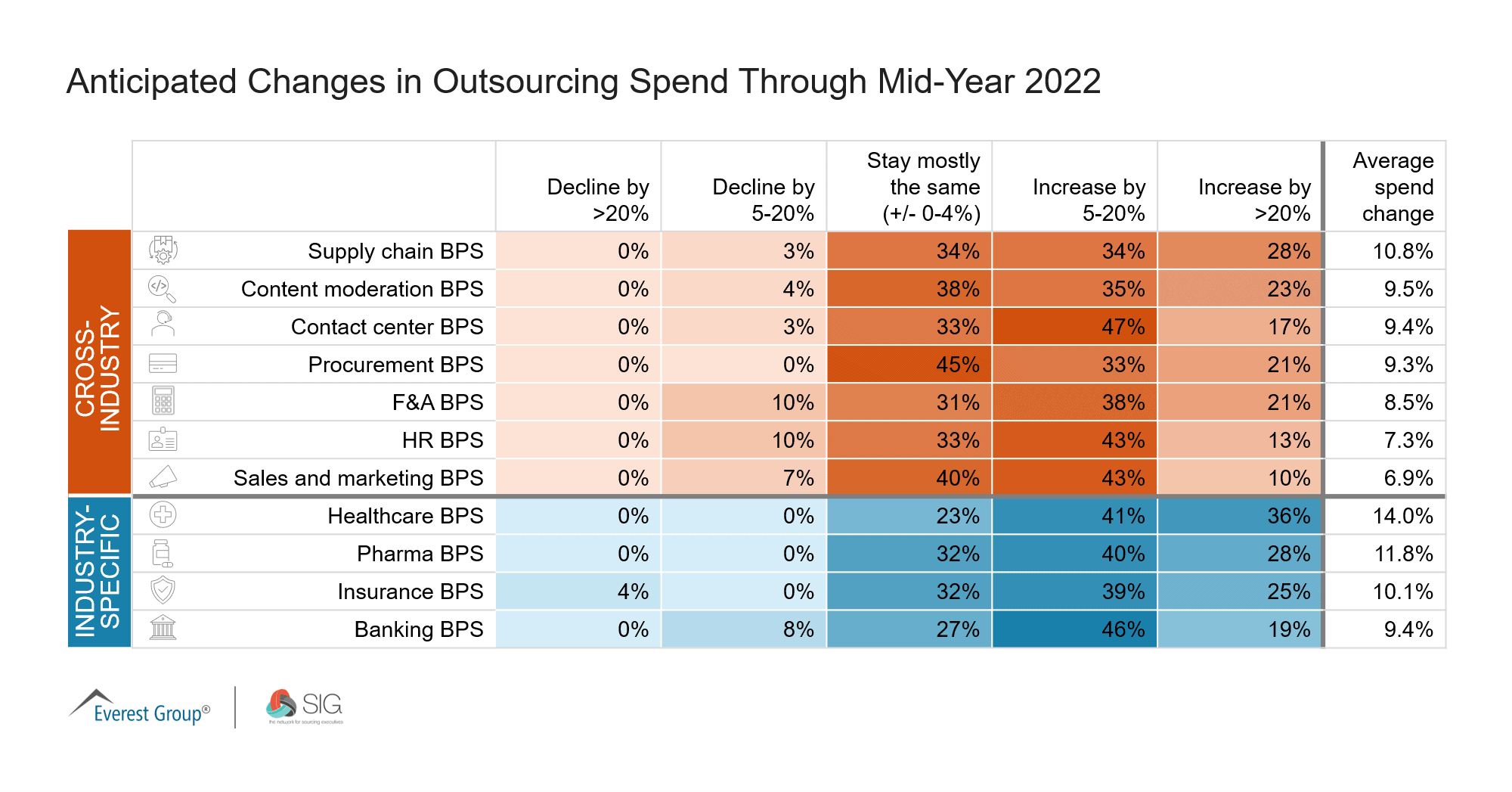Everest Group’s Chhandak Biswas will join a webinar to discuss how gamification can transform the customer experience management (CXM) landscape and create a motivated, high-performing workforce.
The panel will discuss:
The government needs to improve the ease of doing business to allow the business process outsourcing industry to hit its export revenue and job generation targets, the Contact Center Association of the Philippines (CCAP) said.
The CCAP said the industry’s headcount rose in 2021 by up to 10%, or over 120,000 jobs. It was citing data from global research firm Everest Group.
Contact Center-as-a-Service

VIEW THE FULL REPORT
Contact Center-as-a-Service

VIEW THE FULL REPORT
While organizations are certainly familiar with on-premise technologies in contact centers, today’s enhancement on the premise-based technology model is delivering an exceptional digital customer experience, innovation, flexibility, and lower cost. Meet the Contact Center as a Service (CCaaS) operated on the cloud. To learn more about this fast-growing omnichannel cloud contact center solution being adopted across all industries and geographies, read on.
Contact centers are becoming an area of strategic focus for organizations as they strive to deliver business impact through superior Customer Experience (CX). Traditionally, contact centers have run on technologies hosted on-premise with physical hardware such as servers, storage systems, security systems, dialers, and Private Branch Exchange (PBX) hosted in premises or in-house data centers. But that is changing.
Most organizations are now opting for cloud-based contact center solutions by migrating their existing premise-based applications to cloud and/or deploying cloud-native applications as they look to digitally transform their CX operations. In the past few years, the growing need to quickly deploy contact center technology and the increasing use of digital solutions such as Artificial Intelligence (AI), automation, and analytics has paved the way for a flexible cloud contact center offering called Contact Center as a Service (CCaaS).
With COVID-19 pushing the boundaries of innovation and demand for digitally-infused customer experience increasing, CCaaS is poised to be at the forefront of the digital transformation of contact centers. In this blog, we will explore CCaaS, its impact on customer experience, and the financial benefits from leveraging these solutions.
CCaaS (also known as hosted contact center) is a contact center solution that allows organizations to utilize third-party contact center software hosted on cloud. It provides all the essential components that comprise a conventional contact center such as PBX, Interactive Voice Response (IVR), Automatic Call Distribution (ACD), Computer Telephony Integration (CTI), voice and non-voice channels, along with other digital solutions such as omnichannel platform, workforce management, automation, and quality management. It is usually offered as a subscription-based (per seat, per user, per month, per transaction) model, and the CCaaS vendor is responsible for regular maintenance and upgrades.

With increasing customer expectations of service and support, improved contact center technology has been a key enabler of seamless service delivery. CCaaS brings together all the essential tools and technologies required by contact centers to deliver a superior customer experience. Here are three possible ways CCaaS can positively impact customer experience:
A key benefit of CCaaS adoption is long-term cost savings. The business case depends on the size of the contact center, existing investments, the propensity to drive value through next-generational technologies, and the nature of the partnership with the CCaaS vendor to drive a successful transformation effort. Let us explore the potential cost savings that contact centers of different sizes can achieve practically:

Our recent research shows that as companies accelerate their cloud adoption journeys and scale their contact center operations, leveraging an agile and holistic CCaaS solution will increase many-fold. With many companies moving towards flexible business models, the future of CCaaS looks promising.
Do you foresee adopting CCaaS as part of your cloud adoption journey? Read our report Demystifying Contact Center-as-a-Service (CCaaS): Customer Experience Management (CXM) Market Report 2021 and share your thoughts by emailing [email protected], [email protected], [email protected], [email protected].
Outsourcing spend

SEE ALL OF OUR QUICK POLLS
With one of the largest acquisitions in the contact center outsourcing market in recent years, Sitel Group is poised to become a powerhouse with its acquisition of SYKES Enterprises, Inc. This union will likely set off greater investment in customer experience management services (CXM) and more industry consolidation. Read on to find out what this big deal will mean.
The contact center outsourcing market is huge, about 90 billion dollars in annual revenues, and the industry is seeing more attention and growth than ever. So, the announcement of the agreement of Sitel Group acquiring all of SYKES’ outstanding shares in a transaction valued at approximately $2.2 billion is another in a growing list of investments in this space, albeit a large one.
Over the last two to three years, most acquisitions by large contact center providers have focused on bringing new capabilities and technologies to an existing footprint, whereas the Sitel Group / SYKES deal calls out gaining additional global presence as one of the main reasons for the acquisition. We have not seen something of this scale for a few years, probably not since the Concentrix acquisition of Convergys.
This acquisition forms a $4 billion customer experience management services (CXM) organization with over 150,000 agents, making Sitel Group one of the three largest organizations in the industry alongside Teleperformance and Concentrix. In this blog, we’ll explore what this acquisition means for Sitel Group, its existing and potential customers, as well as the CXM industry as a whole.
Here are a few of the key impacts we expect:
In terms of vertical expertise, Sitel Group and SYKES have complementary strengths, with Sitel Group bringing presence in the retail, insurance, and public sector spaces and SYKES bringing strength in the technology and healthcare industries.
While Sitel Group’s acquisition of SYKES will bring additional and much-needed digital capabilities to the new combined business, a company the size of the new organization cannot deliver change and adjust to new offerings and skills overnight. It may take some time to fully deliver new digital capabilities at scale.
As the contact center industry aims to better understand the customer and improve customer experience, we’re seeing many investments in the market.
Service providers across the board are investing in technologies and skillsets to become more digital and get ahead of the curve to offer better customer experiences. They are finding organizations more willing to spend money to improve customer service, an area where in the past, they treated simply as a cost base that needed to be reduced, but are now recognizing its potential strategic and topline business impact. Smaller service providers are taking advantage of their agility and are quickly adapting to a digital-first CXM business, and larger providers are having to work hard to keep pace with the rate of digital adoption.
Expect to see more public and non-public deals happening. With the size of this market and everyone working towards digital transformation, a trend that has further accelerated due to vulnerabilities exposed by COVID-19, the contact center outsourcing industry is really ripe for investment.
These deals will result in a consolidation in the marketplace but with bigger market growth. Penetration of contact center outsourcing could increase from roughly 30 percent to upwards of 35 percent in the next few years – resulting in a faster rate of growth than we’ve seen in the past decade.
It will not only be due to big service providers getting even larger. Smaller service providers will need to rapidly articulate their differentiation to remain relevant in a crowded marketplace, such as in a process area or industry domain; otherwise, they run the risk of being in a race towards the bottom.
You can also attend our LinkedIn Live session, Who is Leading Customer Experience Management (CXM) Services in Europe?, to learn the results of our recently completed PEAK Matrix® assessment showcasing our latest CXM research in the EMEA region.
As businesses across industries adapt to the next normal, digital channels are becoming the preferred, or in some cases the only, way of providing customer support for products and services. While many contact centers are simply unable to handle the increased volume of requests and inquiries with their existing workforce and technologies, some enterprises are already rethinking what customer service stands for. Many are turning to sophisticated Digital Employees, also known as, Interactive Virtual Agents (IVA,) enabled with conversational AI and secure backend integrations to deliver customer service in a scalable and cost-efficient way, without jeopardizing quality.
On this webinar, Everest Group’s Skand Bhargava, a featured guest speaker, joins Jonathan Crane from IPSoft, who are the manufacturers of a market-leading digital employee, Amelia, to discuss how IVA and conversational AI can elevate contact center operations. Also joining them will be Gonzalo Gomez Cid from Telefónica who will be sharing his company’s experience in implementing conversational AI in contact centers.
May 28th, 2020, 10 AM ET
Skand Bhargava
Practice Director
Everest Group
Jonathan Crane
Chief Commercial Officer
IPSoft
Gonzalo Gomez Cid
Global Contact Center Director
Telefonica
Do you know anyone who hasn’t had a frustrating experience because the contact center rep they interacted with didn’t speak their native language? We didn’t think so.
The truth is that while enterprises have multiple business reasons for establishing their contact centers in offshore locations in Eastern Europe, Latin America, and Asia Pacific, the reps’ language and communication skills often have a negative impact on the overall customer and brand experience.
And although many companies have developed their own solutions to assess candidates’ language capabilities, they’re plagued with multiple challenges, including:
Commercial language and communication assessment solutions have been around for years. But innovative vendors – such as Pearson, an established player in this market, and Emmersion Learning, which incorporates the latest AI technology into its solution – are increasingly leveraging a combination of linguistic methodologies, technical automation, and advanced statistical processes to deliver a scalable assessment that can predict speaking, listening, and responding proficiency.
For instance, technology-driven solutions may test candidates’ “language chunking” ability, which means their ability to group chunks of semantic meaning. This concept is similar to techniques that are commonly used for memorizing numbers. By linking numbers to concepts, a person can be successful in retaining large sequences of digits in working memory. Without conceptual awareness, memorization is hard.
During an assessment, through automation and AI, the candidate may be asked to repeat sentences of increasing complexity. Success in this exercise relies on the candidate’s ability to memorize complex sentences, which can only be done when they can chunk for meaning. A candidate’s mastery of an exercise to repeat sentences of increasing complexity is a great predictor of the candidate’s language proficiency.
Organizations that embrace technology-based solutions for language assessments can anticipate multiple benefits: reduced costs, decreased hiring cycle times, improved quality of hires, better role placement, freed time to devote to value-add initiatives, and improved customer experience and satisfaction. Ultimately, it’s a triple win for the organization, its candidates, and its customers.

©2023 Everest Global, Inc. Privacy Notice Terms of Use Do Not Sell My Information
"*" indicates required fields